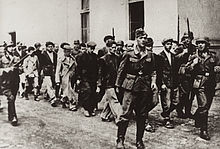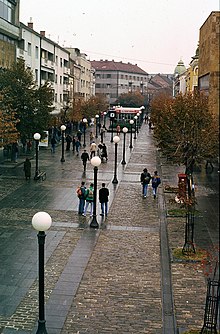Kragujevac
|
Крагујевац Kragujevac |
||||
|
||||
| Basic data | ||||
|---|---|---|---|---|
| State : | Serbia | |||
| Okrug : | Sumadija | |||
| Coordinates : | 44 ° 1 ′ N , 20 ° 55 ′ E | |||
| Height : | 180 m. i. J. | |||
| Area : | 835 km² | |||
| Residents : | 150,835 (2011) | |||
| Agglomeration : | 180,252 (2011) | |||
| Population density : | 181 inhabitants per km² | |||
| Telephone code : | (+381) 034 | |||
| Postal code : | 34,000 | |||
| License plate : | KG | |||
| Structure and administration (as of 2017) | ||||
| Community type: | city | |||
| Structure : | 5 boroughs | |||
| Mayor : | Radomir Nikolić ( SNS ) | |||
| Website : | ||||
(pronunciation: [ˈkrǎɡujɛvats] ;Serbian-Cyrillic Крагујевац) is the fourth largest city inSerbia. The city itself has almost 150,835 inhabitants, themunicipality ofthe same nameabout 180,000 inhabitants. It is theadministrative seat ofthecentral Serbian district of Šumadija. The city has a well-developedarmsandautomotiveindustries. In 1838 the firstSerbianhigher education institution inrecent history was foundedin Kragujevac, as well as the first elementary school (grammar school), printing works (both in 1833), today'sKnjaževsko-srpski teatar(1834) and the first military academy (1837). It is also the twin town ofIngolstadtand, since 1961, ofSuresnes(France).
Geographical location
Kragujevac is located about 140 km southeast of Belgrade in the region and the Šumadija district of the same name, central in the Republic of Serbia .
City structure
The city of Kragujevac consists of five municipal districts, which are divided into several municipalities. Stragari is the only district whose district center is not in the urban center of the city of Kragujevac, but in the northwest on the city limits. The district of Stari Grad is not further subdivided and is therefore the smallest district:
|
|
|
|
|
history
The city was first mentioned in Turkish documents in the 15th century as the city of Kragujevdža . With Kragujevdža a sparrow hawker was meant, as Kraguj is a type of sparrow in Serbian . Kragujevac could be translated as Sparrowhawk City. In the period from 1818 to 1839, Kragujevac was together with Požarevac the capital of Serbia . Belgrade was officially the capital of Serbia until 1867, but due to the presence of an Ottoman regiment in the Belgrade Kalemegdan fortress (Serbia was an autonomous principality at the time), all important state institutions remained in Kragujevac. In 1867 Prince Mihailo Obrenović was supposed to force the last Ottoman regiments to leave the principality. Belgrade was finally declared the capital and all state institutions were moved there. From 1869 to 1884 the Serbian Orthodox Assumption Cathedral was built in the city center .
The German Wehrmacht occupied the city and carried out a massacre. In retaliation for a partisan attack, the Wehrmacht shot and killed over 2,300 residents on October 21, 1941, including 300 students and 18 teachers from the local high school. Several monuments in the Memorial Park on October 21 commemorate the victims of that time (see Kraljevo and Kragujevac massacres ). These acts of violence inspired the poet Desanka Maksimović to write the poem Krvava Bajka (Bloody Fairy Tale). In memory of the war and the terrible massacre, the city became involved in peace work. She launched several competitions in which artists are awarded for their work for peace, e.g. B. a competition for anti-war caricatures. The city was honored by the UN in 1986 for this commitment and in 1988 was awarded the Peace Medal of the French city of Verdun . The last survivor of the massacre was Dragoljub Jovanović (1924-2018), who later became the director of the Šumarice Memorial Park for many years and was 16 years old at the time of the massacre. He was hit in the leg by several bullets, but survived by pretending to be dead. He is one of around 40 survivors of the massacre.
population
| year | Population of the municipality (opština) Kragujevac |
|---|---|
| 1961 | 104,782 |
| 1971 | 130,551 |
| 1981 | 164,823 |
religion
In the vicinity of Kragujevac there are several medieval monasteries and churches such as the Divostin and St. Nicholas (Sv. Nikola) monasteries , both from the 13th century , and the Drača monastery of as yet unknown age. These three monasteries already existed at the time of the battle on the Amselfeld in 1389 . At that time it was documented that on the day of the battle and the days before it, an enormous number of women, children and elderly people visited the monasteries to pray.
The Church of the Cremation of the Relics of St. Sava has existed since 2000.
Culture
The association "Abrašević" with its approx. 600 members is one of the largest cultural associations in Serbia.
Many architectural styles can be found side by side in the city . There are traditional buildings in the Serbian-Turkish Balkan style alongside classicist architecture from the 19th century , socialist standardized construction and modern skyscrapers .
economy
Kragujevac is an important industrial city in central Serbia. The best-known company that originated here is the automobile and arms manufacturer Zastava , which has been supplying the former Yugoslavia with cars since the 1950s, including the Fića models (Zastava 750), an earlier licensed version of the Fiat 600 , and the Yugo Coral .
Following a contract signed in September 2008 between the Serbian government and Fiat , the company started building a new car plant in Kragujevac in 2009. Investments totaling one billion euros are planned. By the end of 2012, the Fiat plant is expected to create 2,400 jobs and 1,000 more at supplier companies in the area. According to Fiat, the plant can produce up to 200,000 vehicles per year at full capacity.
traffic
Road traffic
Kragujevac has a relatively well-developed and dense road network. A motorway is currently being built to connect the city with the Belgrade – Preševo motorway.
Bus transport
From Kragujevac there are direct connections to other major Serbian cities (e.g. Belgrade ). But the bus network is also very dense in urban areas and there are many buses.
Train traffic
In 1886 Kragujevac got a railway connection that connected the city via Lapovo to the Belgrade-Niš railway line (in the south towards Sofia / Istanbul and Skopje / Thessaloniki). Today the line is operated by the Serbian railway company Železnice Srbije .
The train station is next to the bus station. There is a train from Kragujevac to Lapovo five times a day (as of 2020). Travelers to Belgrade have to change trains in Lapovo.
| 1965 | 1967 | 1972 | 1975 | 1980 | 1983 | 1987 | |
|---|---|---|---|---|---|---|---|
| Number of departed passengers | 672,000 | 599,000 | 293,000 | 248,000 | 226,000 | 261,000 | 331,000 |
Twin cities
Kragujevac is twinned with the following cities:
-
Suresnes , France (since 1967, interrupted from 1992 to 1997)

-
Pitești , Romania (since 1971)

-
Trenčín , Slovakia

-
Opole , Poland

-
Bydgoszcz , Poland (since 1971)

-
Bielsko-Biała , Poland (since 2002)

-
Springfield, Ohio , United States (since 2002)

-
Ohrid , North Macedonia (since 2002)

-
Ingolstadt , Germany (since 2003)

-
Hanover , Germany

-
Carrara , Italy

-
Reggio nell'Emilia , Italy (since 2004)

-
Verona , Italy

-
Mostar , Bosnia and Herzegovina

-
Foča , Bosnia and Herzegovina

-
Mahiljou , Belarus (since 2006)

-
Karlovac , Croatia

-
Drama , Greece

-
Bat Jam , Israel

sons and daughters of the town
- Milan I. Obrenović (1819–1839), Prince
- Mihailo Obrenović (1823–1868), Prince
- Jovan Ristić (1831–1899), Prime Minister of Serbia
- Radomir Putnik (1847–1917), Chief of Staff of the Serbian Army
- Mija Aleksić (1923–1995), actor
- Branislav Ciga Jerinić (1932–2006), actor
- Dragomir Bojanić Gidra (1933–1993), actor
- Mirko Babić (* 1948), actor
- Tomislav Nikolić (* 1952), former President of Serbia
- Gorica Popović (* 1953), actress
- Mirko Puzović (* 1956), boxer
- Miroslav Jović (* 1971), football player and coach
- Predrag Đorđević (* 1972), football player
- Stevan Pletikosić (* 1972), marksman
- Marija Šestak (* 1979), Yugoslav-Slovenian athlete
- Danko Lazović (* 1983), football player
- Jelena Tomašević (* 1983), singer
- Katarina Bulatović (* 1984), handball player
- Marija Šerifović (* 1984), singer
- Nemanja Pejčinović (* 1987), football player
- Nemanja Tomić (* 1988), football player
- Zlatko Muhovic (* 1990), football player
- Luka Milivojević (* 1991), football player
- Filip Kostić (* 1992), football player
Web links
Individual evidence
- ↑ pod2.stat.gov.rs
- ↑ pod2.stat.gov.rs
- ^ Walter Manoschek : The massacres in Pančevo and Kragujevac in autumn 1941. On the German policy of repression against the civilian population in occupied Serbia. In: Oliver von Wrochem (Hrsg.): Repressalien und Terror: "Vergeltungsaktion" in German occupied Europe 1939-1945. Ferdinand Schöningh, Paderborn 2017, ISBN 978-3-506-78721-7 , pp. 89-102.
- ^ Exhibition "Anti-War Caricatures" of the twin town Kragujevac in Ingolstadt ( Memento from October 10, 2016 in the Internet Archive ).
- ↑ Michael Martens : Survival in Kragujevac. In: Frankfurter Allgemeine Zeitung. June 2, 2012, p. 3. (extensive interview article about Jovanović)
- ↑ Savezni zavod za statistiku (ed.): Statistički godišnjak Jugoslavije . God. 15. Beograd 1968, p. 525 .
- ↑ Savezni zavod za statistiku (ed.): Statistički godišnjak Jugoslavije . God. 23. Beograd 1976, p. 565 .
- ↑ Savezni zavod za statistiku (ed.): Statistički godišnjak Jugoslavije . God. 32. Beograd 1984, p. 622 .
- ^ The return of FIAT to Serbia. wieninternational.at, October 8, 2008 ( Memento from August 10, 2014 in the Internet Archive )
- ^ Opening of the FIAT plant in Kragujevac. fiatpress.de, April 2012
- ↑ Red vožnje. In: Srbija voz ad.Retrieved January 3, 2020 .
- ↑ Savezni zavod za statistiku (ed.): Statistički godišnjak Jugoslavije . Beograd.
- ↑ Comune di Verona - Grandi Eventi - Gemellaggi e Patti d'Amicizia. Retrieved April 24, 2018 .






